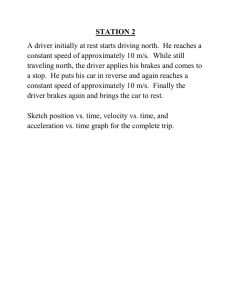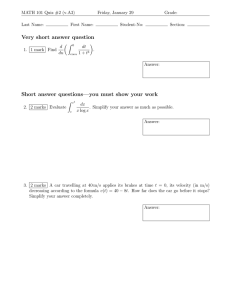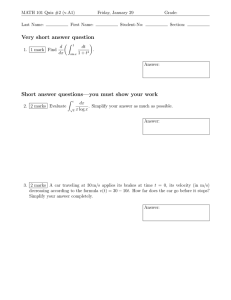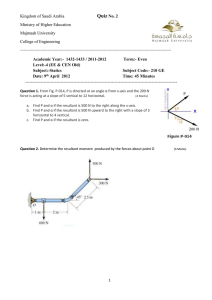Physics Exam Paper: Distance, Displacement, Energy, Forces
advertisement
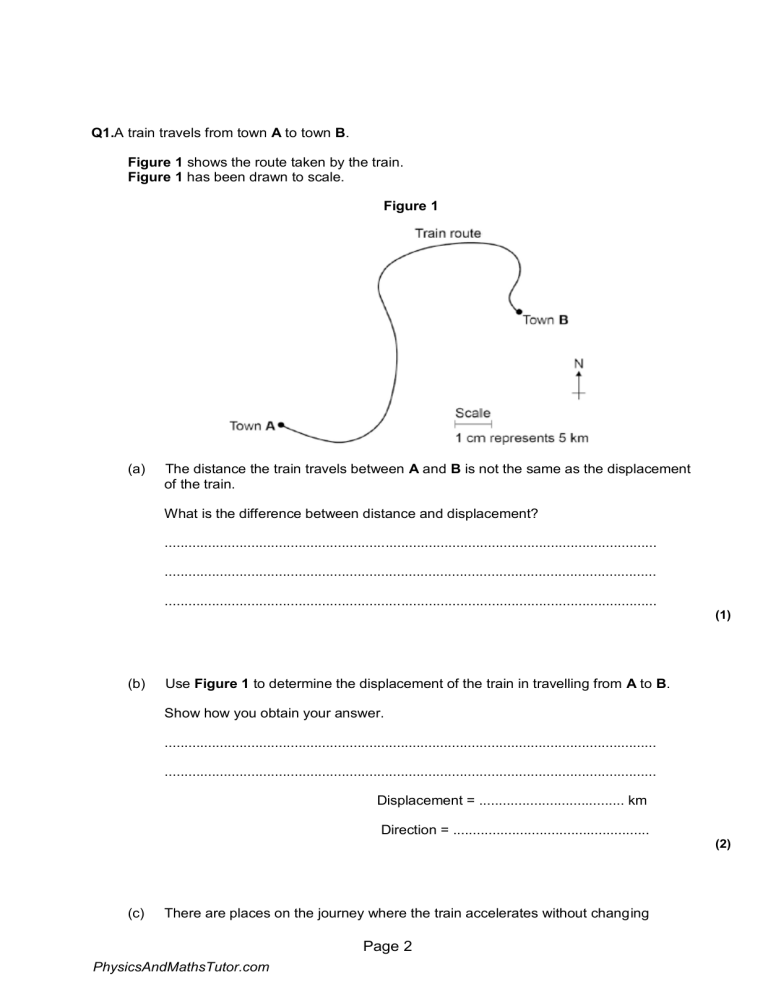
Q1.A train travels from town A to town B. Figure 1 shows the route taken by the train. Figure 1 has been drawn to scale. Figure 1 (a) The distance the train travels between A and B is not the same as the displacement of the train. What is the difference between distance and displacement? ............................................................................................................................. ............................................................................................................................. ............................................................................................................................. (1) (b) Use Figure 1 to determine the displacement of the train in travelling from A to B. Show how you obtain your answer. ............................................................................................................................. ............................................................................................................................. Displacement = ..................................... km Direction = .................................................. (2) (c) There are places on the journey where the train accelerates without changing Page 2 PhysicsAndMathsTutor.com speed. Explain how this can happen. ............................................................................................................................. ............................................................................................................................. ............................................................................................................................. ............................................................................................................................. (2) (d) Figure 2 shows how the velocity of the train changes with time as the train travels along a straight section of the journey. Figure 2 Estimate the distance travelled by the train along the section of the journey shown in Figure 2. Page 3 PhysicsAndMathsTutor.com To gain full marks you must show how you worked out your answer. ............................................................................................................................. ............................................................................................................................. ............................................................................................................................. ............................................................................................................................. Distance = .................................................. m (3) (Total 8 marks) Page 4 PhysicsAndMathsTutor.com Q2. The diagram shows an orbiter, the reusable part of a space shuttle. The data refers to a typical flight. (a) (i) What name is given to the force which keeps the orbiter in orbit around the Earth? ................................................................................................................... (1) (ii) Use the following equation to calculate the kinetic energy, in joules, of the orbiter while it is in orbit. kinetic energy = ½ mv2 ................................................................................................................... ................................................................................................................... Kinetic energy = ............................. joules (2) (iii) What happens to most of this kinetic energy as the orbiter re-enters the Earth’s atmosphere? ................................................................................................................... ................................................................................................................... (1) (b) After touchdown the orbiter decelerates uniformly coming to a halt in 50 s. Page 5 PhysicsAndMathsTutor.com (i) Give the equation that links acceleration, time and velocity. ................................................................................................................... (1) (ii) Calculate the deceleration of the orbiter. Show clearly how you work out your answer and give the unit. ................................................................................................................... ................................................................................................................... Deceleration = ............................... (2) (c) (i) Give the equation that links acceleration, force and mass. ................................................................................................................... (1) (ii) Calculate, in newtons, the force needed to bring the orbiter to a halt. Show clearly how you work out your answer. ................................................................................................................... ................................................................................................................... Force = ............................ newtons (1) (Total 9 marks) Page 6 PhysicsAndMathsTutor.com Q3. A driver is driving along a road at 30 m/s. The driver suddenly sees a large truck parked across the road and reacts to the situation by applying the brakes so that a constant braking force stops the car. The reaction time of the driver is 0.67 seconds, it then takes another 5 seconds for the brakes to bring the car to rest. (a) Using the data above, draw a speed-time graph to show the speed of the car from the instant the truck was seen by the driver until the car stopped. (5) (b) Calculate the acceleration of the car whilst the brakes are applied. ............................................................................................................................. ............................................................................................................................. ............................................................................................................................. Page 7 PhysicsAndMathsTutor.com Answer = .................................... m/s2 (3) (c) The mass of the car is 1500 kg. Calculate the braking force applied to the car. ............................................................................................................................. ............................................................................................................................. ............................................................................................................................. Answer = .................................... N (3) (d) The diagrams below show what would happen to a driver in a car crash. (i) Explain why the driver tends to be thrown towards the windscreen. ................................................................................................................... ................................................................................................................... ................................................................................................................... ................................................................................................................... ................................................................................................................... ................................................................................................................... (ii) The car was travelling at 30 m/s immediately before the crash. Calculate the energy which has to be dissipated as the front of the car crumples. ................................................................................................................... Page 8 PhysicsAndMathsTutor.com ................................................................................................................... ................................................................................................................... ................................................................................................................... (8) (Total 17 marks) Page 9 PhysicsAndMathsTutor.com Q4.(a) The graphs show how the velocity of two cars, A and B, change from the moment the car drivers see an obstacle blocking the road. Time in secondsTime in seconds One of the car drivers has been drinking alcohol. The other driver is wide awake and alert. (i) How does a comparison of the two graphs suggest that the driver of car B is the one who has been drinking alcohol? ............................................................................................................... ............................................................................................................... (1) (ii) How do the graphs show that the two cars have the same deceleration? ............................................................................................................... ............................................................................................................... (1) (iii) Use the graphs to calculate how much further car B travels before stopping compared to car A. Show clearly how you work out your answer. ............................................................................................................... ............................................................................................................... Page 10 PhysicsAndMathsTutor.com ............................................................................................................... Additional stopping distance = .................................................. m (3) (b) In a crash-test laboratory, scientists use sensors to measure the forces exerted in collisions. The graphs show how the electrical resistance of 3 experimental types of sensor, X, Y, and Z, change with the force applied to the sensor. Which of the sensors, X, Y or Z, would be the best one to use as a force sensor? .................................................. Give a reason for your answer. ........................................................................................................................ ........................................................................................................................ ........................................................................................................................ ........................................................................................................................ (2) (Total 7 marks) Page 11 PhysicsAndMathsTutor.com Q5.The London Eye is one of the largest observation wheels in the world. © Angelo Ferraris/Shutterstock The passengers ride in capsules. Each capsule moves in a circular path and accelerates. (a) Explain how the wheel can move at a steady speed and the capsules accelerate at the same time. ........................................................................................................................ ........................................................................................................................ ........................................................................................................................ (2) (b) In which direction is the resultant force on each capsule? ........................................................................................................................ (1) (c) The designers of the London Eye had to consider three factors which affect the resultant force described in part (b). Two factors that increase the resultant force are: • an increase in the speed of rotation • an increase in the total mass of the wheel, the capsules and the passengers. Page 12 PhysicsAndMathsTutor.com Name the other factor that affects the resultant force and state what effect it has on the resultant force. ........................................................................................................................ ........................................................................................................................ (1) (Total 4 marks) Page 13 PhysicsAndMathsTutor.com
